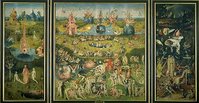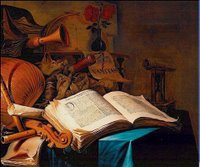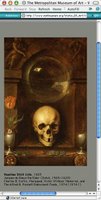(59) counting and measuring time
 The Garden of Delights/El Jardín de las Delicias differs from many vanitas images in the sense that it does not include much in the way of images of time measuring, for instance clocks and hourglasses, although it does include images of pain that would increase over time, fruit that could go bad,
The Garden of Delights/El Jardín de las Delicias differs from many vanitas images in the sense that it does not include much in the way of images of time measuring, for instance clocks and hourglasses, although it does include images of pain that would increase over time, fruit that could go bad, boats that could capsize, etc.
boats that could capsize, etc. The emphasis is on counting time, with two daytime scenes and one night scene. The obvious link is to Genesis where time is marked by days (defined as evening and morning, Appellavitque lucem Diem, et tenebras Noctem: factumque est vespere et mane, dies unus). There is also musical notation in the right panel, which also seems to relate to counting time. There is a complex series of images relating to the Jewish calendar, which involves counting days and full moons, and there is a series of images marking years in an eccentric version of Nahuatl picture writing. The explanations will be long and complicated both for the Jewish calendar and the Nahuatl annals, both of which seem to be memory systems devised for learning and recalling, but it seems worth noting at the start that the point seems to have been to emphasize and facilitate translating one into the other. Measuring time in terms of hours or even relative age (as in the steadily decaying books in the painting by Jan Lievens) could come later.
The emphasis is on counting time, with two daytime scenes and one night scene. The obvious link is to Genesis where time is marked by days (defined as evening and morning, Appellavitque lucem Diem, et tenebras Noctem: factumque est vespere et mane, dies unus). There is also musical notation in the right panel, which also seems to relate to counting time. There is a complex series of images relating to the Jewish calendar, which involves counting days and full moons, and there is a series of images marking years in an eccentric version of Nahuatl picture writing. The explanations will be long and complicated both for the Jewish calendar and the Nahuatl annals, both of which seem to be memory systems devised for learning and recalling, but it seems worth noting at the start that the point seems to have been to emphasize and facilitate translating one into the other. Measuring time in terms of hours or even relative age (as in the steadily decaying books in the painting by Jan Lievens) could come later.
There are also publication dates, of which the most striking is the 1492 publication of Nebrija’s Gramática de la lengua castellana, represented by a hieroglyph that Nebrija described in the text. These are helpful for establishing the date of the triptych, although in some instances the artist might have known about a book that was not yet published, and it is also interesting that printed title pages that include years of publication are not very dissimilar to Nahuatl annals. A title page often includes some sort of picture, and a year in Roman or Arabic numerals, and title pages might have seemed less peculiarly European than the rest of the book.



0 Comments:
Post a Comment
<< Home